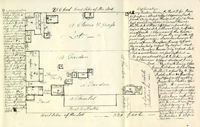Greenhow Brick Office Historical Report,
Block 13-2 Building 20 Lot 160 Originally entitled: "Colonial Prison (Block 13, Colonial Lot 160)"
Colonial Williamsburg Foundation Library Research Report Series - 1260
Colonial Williamsburg Foundation Library
Williamsburg, Virginia
1990
COLONIAL PRISONGreenhow-Repiton Brick Office
(Block 13, Colonial Lot 160)
LOCATION:
The brick building known as the "Debtors' Prison" stands in the James City County portion of Williamsburg on colonial lot #160, facing the Market Square.
PROBLEM:
According to tradition, this building was a "Debtors' Prison," although tradition does not tell us whether it was a county or a city prison (either of which could have held debtors). There is little documentary evidence to indicate the building's use prior to the nineteenth century, when it was in private hands. The destruction of the records for James City County and the City of Williamsburg, in the War Between the States, has removed the most likely source of information concerning either prison.
We do know that during the eighteenth century a county prison and a city prison were erected in Williamsburg, in addition to the Colony Prison (or Public Gaol) near the Capitol. Apparently, at one time the city used the James City County prison, and then ordered a city prison to be built; and several years after the removal of the capital to Richmond, both the city and the county used the old Colony Prison.
In 1715, the county seat for James City County was moved from James-town to Williamsburg.1 Between 1715 and 1722 a county courthouse had been erected in Williamsburg. Hugh Jones (who left Virginia for England in 1722) mentioned the courthouse as standing not far from the Powder Magazine.2 This 2 county courthouse stood on colonial lot 204;1 and, according to a record of 1769, the county jail stood on the lot with it.2 It was customary for county jails to be erected near the courthouses, and it is probable that the James City County jail was built about the time of the courthouse (circa 1715).
If the county prison stood with the courthouse on colonial lot 204, the brick building on colonial lot 160, if a prison, may have been the prison for the City of Williamsburg, ordered to be built in 1744, the James City County prison having "hitherto been used for that purpose."3 However, again, we have found no record as to exactly when or where the city prison was erected. We do not know where the City of Williamsburg (incorporated in 1722) held its Husting Court prior to 1745 - possibly the city used the James City County Courthouse as well as the county jail. In 1745, it was ordered, by the Common-Hall of the city, that the old Playhouse on Palace Green be fitted up as a courthouse,4 the city having leased that building with six feet of ground on all sides of it.5 Obviously, there would have been no room for a prison on the Playhouse land leased by the city; and it is possible that the prison would have been erected on the Market Square, as that land belonged to the city. Lacking other evidence, it may not be considered unreasonable to assume that the building known as the "Debtors' Prison" standing on colonial lot 160 was a prison erected for the City of Williamsburg circa 1744.
In any case, the following history presents what little is known concerning the county and city prisons; and gives the nineteenth century information 3 that has been found on colonial lot 160.
HISTORY:
In 1705, an act was passed by the Assembly directing the building and maintaining of "prisons, pillories, whipping-posts," &c in every county.1 It was customary in Virginia for county prisons to stand near the courthouses. It is reasonable to suppose that a prison was erected near the James City County Courthouse (colonial lot 204) about the time that the courthouse was erected at Williamsburg. In 1715, in opposition to Governor Spotswood's having moved the county seat for James City County from Jamestown to Williamsburg, some of the county justices petitioned to be allowed to "Erect a Court House together with all other buildings by Law required to be built,"2 in some other place than Williamsburg. The petition was rejected and it can be assumed that all the "other buildings by Law required" were erected in Williamsburg near the Courthouse.
A record of 1744 gives the information that the county prison of James City was also being used for the commitment of "debtors, criminals, and offenders" by the city "on sufferance" since it (the city) had no jail. (Hening, Statutes at Large, V, 263-264.) In 1744, a petition of the mayor, recorder, aldermen and common council of the city of Williamsburg, asking to be allowed to build a city prison, was granted:
"September 1744
I. WHEREAS the mayor, recorder, aldermen, and common council of the City of Williamsburg have represented to this General Assembly, that there is no prison belonging to their corporation, for the commitment of debtors, criminals, and offenders; but that the prison of James City county standing within the limits of the said city, hath hitherto been used for that purpose, 4 on sufferance; which is attended with inconvenience both to the said county and city; and that they are desirous a prison should be built for the use of the said city, at the charge of the inhabitants of the corporation:…
(Hening, Statutes at Large, V, 263-264.)
II. Be it therefore enacted…That it shall and may be lawful for the mayor, recorder, aldermen, and common council of the said city of Williamsburg…to levy and assess, by the poll…all such sum and sums of money as shall be necessary, for erecting a prison for the use of the said city…"1
There are no records yet found which prove that the city prison was built in or about 1744; but it is highly probable that the prison was built soon thereafter.2 From an act of 1764, one would infer that the city had built a prison prior to that date:
"January 1764
An act to empower the corporation of the City of Williamsburg to assess taxes on the inhabitants thereof for the purposes therein mentioned, and for repealing a certain act of Assembly therein also mentioned.
(Hening, Statutes at Large, VIII, pp. 21-23.)
…
2. Be it therefore enacted…That it shall and may be lawful for the mayor, recorder, aldermen, and common-council, of the said city of Williamsburg, for the time being, in common-hall assembled, to levy and assess by the poll, on the tithable persons inhabiting within the 5 said city, all such sum and sums of money as shall be sufficient for defraying the charges and expenses of building a court-house, market-house, and prison, for the said city, when those now in use shall happen to fall to decay, or be otherwise destroyed, and to keep the same in repair…"
In November 1769, an agreement was made between the justices of James City County and the mayor, aldermen and common council of Williamsburg to build a new courthouse at their joint expense. The power to sell the land whereon the present county courthouse and prison stood was also given by the Assembly and the use to which the money was to be put, stated clearly:
The above quotation gives weight to the belief that the county prison was located on the same lot with the old courthouse. If this be true, then the brick building on lot 160 (known by tradition as the "Debtors' Prison" may have been used by the Corporation of Williamsburg as a city prison from 1744 (when Williamsburg citizens were given permission by the Assembly to build a prison for the use of the city), until prior to June, 1784 (when the city was using the Public Gaol near the Capitol). In 1784, several years after the removal of the seat of government to Richmond, James City County was given permission to use the old public gaol near the Capitol. At the time the petition was granted, the city of Williamsburg was already using the public gaol or prison. The need for repairs to the James City County Prison was noted as sufficient reason to apply for joint use by county and city: 6"… November 1769
II. And be it further enacted…That the said justices of James City, be, and they are hereby impowered to sell, at public auction, for the best price that can be got for the same, the land whereon their present court-house and prison stand (being part of a lot in the said city) together with the court-house and that they, the said justices, or any four of them shall and may convey the same to the purchaser or purchasers… and shall apply the money arising from such sale towards… the expenses of building the new court-house."
(Hening, Statutes at Large, VIII, 420.)
"June 5, 1784 The Petition of the Justices of the County of James City Humbly sheweth that the public Jail in the City of Williamsburg is at present not made use of by any but the Corporation of the said City and the Jail of the said County is out of repair & unfit for use. That it would save the expence of repairing the County Jail, to the said County, and do no injury to the public if the said public Gaol should jointly be us'd by the County of James City & the Corporation of the City of Williamsburg. Your Petitioners therefore humbly pray that an Act may pass for that purpose." (Hening, Statutes at Large, XI, p. 381.)
MAPS:
The Frenchman's Map (1782) is the first proof we have seen that there were buildings on what appears to be lot 160. On the lot, several houses are drawn. A square building, just behind a larger house which apparently faces upon the main street, is evidently the brick building known by tradition as the "Debtors' Prison." (See drawing in Illustration #4 of the Appendix.)
The College Map (c. 1791) and the Bucktrout Map (1803) both show the name "Greenhow" on lots 159 and 160. (Maps in Department of Research.)
HISTORY LOT 160:
Just how and when John Greenhow1 came into possession of lot 160 is not known. The Land Tax records for Williamsburg show that Greenhow paid tax on 4 lots in the city in 1782. The Gazette of date, September 19, 1766, gives the notice that John Greenhow's store was "near the Church." Greenhow's son, Robert,2 seems to have inherited most of his property. The said Robert Greenhow was the sole executor of his father's estate:
Williamsburg Tax Transfers for 1788 charge Robert Greenhow with 4 lots "via John Greenhow.""WILLIAMSBURG, September 24, 1787.
Agreeable to the last will and testament of Mr. JOHN GREENHOW, late of this city, will be sold at public sale, 7 on Thursday the 18 of October…all the real and personal estate of the deceased…consisting of a large and commodious Dwelling House on the main street… ROBERT GREENHOW, sole executor"
(Virginia Gazette and Independent Chronicle, John Dixon, ed.)
It is possible that Greenhow leased lot 160 from the Corporation of Williamsburg,1 after the city no longer used the brick building as a prison. According to the record of June 5, 1784, when the Justices of James City County petitioned for a right to use the Public Gaol, the city was already using that gaol. (Hening, Statutes at Large, XI, p. 381.) In 1791, an act was passed which gave the City of Williamsburg "the right to use the public gaol therein":
This is confusing, in that apparently the city was already using the Public Gaol. However, in 1791, the Public Gaol was used by the city, James City County, and the district court, and the brick building on lot 160 may have passed 8 into private hands when the city no longer used it for a prison."October 1791.
Sec. I. BE it enacted by the General Assembly, That from and after the passing of this act, the city of Williamsburg shall have a right to use the public gaol therein, as the gaol of the said city; and the district gaoler therein, shall act as keeper of the gaol of the said city. Nothing in this act shall alter or impair the right of the county of James City, or of the district wherein Williamsburg is, to the use of the said public gaol." (Passed November 14th, 1791.)
(Hening, Statutes at Large, XIII, p. 296. Oct. 16th)
During the period 1806-1810, the records of the Mutual Assurance Society show that Robert Greenhow owned two lots on the south side of the Main Street bounded by the lots of Deneufville, the Market Square, and the Back Street. These lots were undoubtedly lots 159 and 160. Support for this statement is found in a drawing by Greenhow of two of his lots in the city. Greenhow, in writing to Mr. Ast on July 27, 1801, gives his reasons for insuring the houses; and states the location, value, and risk connected with the property. Greenhow also enclosed a drawing, on which he describes "E" (obviously the buildings in question) as an "excellent brick house with cellar & one chimney 27 feet by 18 feet, distant from house F 15 feet-." The building "F," described by Greenhow, is taken to mean the dwelling house (known as the Repiton house in the nineteenth century). Greenhow also designated "F" as a "house occupied by a Tenant." (See Illustration #2 of the Appendix.)
In May 1806, the brick house to the rear of the Repiton dwelling is described in an insurance policy of H. Louis Girardin's.1 Of the dwelling house, it is noted: "This Building is contiguous within 30 feet of 4 wooden houses & 1 Brick covered with wood." Again, the records show that the brick building covered with wood is situated behind the Greenhow-Girardin dwelling. (Insurance Records, Department of Research.)
On April 5, 1810, Greenhow insured a part of lot 160 with the Mutual Assurance Society. He designated building "E" as a "lumber house" and valued it at $1000. The house is further described by Greenhow: "my building on the Court House square now occupied by Joseph Repiton2 situated between the lot 9 of John P Shields on the West--the Market square on the east and on the north and south by parts of the same lot on which it stands in the county of James City…" (Policy #1022, Insurance Book, Department of Research. No drawing.) Note that Greenhow said that the house was occupied by Repiton. Two weeks later, Greenhow made a notation at the bottom of the same policy that he had sold to Mr. Joseph Repiton:
"…Having Sold to Mr Joseph Repiton, the lot & the Improvements on which this brick house is Erected for value by me Received All the Advantages Accruing in Case of Conflagration are consequently Attached to him----Wmsburg April 19th 1810
Ro. Greenhow--"1
A policy issued in August 1811, for the Shields property (lot 159), notes that the building occupied by Shields is "within 30 feet of one brick building covered with wood…" (Policy #1082, a revaluation of #644 and #103, Insurance Book, Department of Research.) The Repiton property is noted as "to the west of Court House Green."
The brick "lumber house" is again insured by Joseph Repiton in June 1815. The policy is a revaluation of buildings formerly declared for assurance by Louis H. Girardin and Robert Greenhow per declarations No. 664 and No. 1022. The "lumber house" is valued at $500. The buildings are described as "my buildings on the main street and Court House Square now occupied by myself--situated between Simon Blocks lot on the west and streets otherwise." (See policy #1524 in Illustration #2 of the Appendix.)
From this point, the history of lot 160, or the part on which the brick building stands, grows even more complicated. It is necessary to study the tax records during this period in order to fully realize the situation regarding 10 the ownerships and leases of the property. (See tax records in Illustration #1 of the Appendix.)
The Repitons seem to have held lot 160 until about 1828. That year David Mason came into the western half of the lot "via Alexander Repiton co-heir and devisee of Joseph Repiton." (See tax records in Illustration #1 of the Appendix.) Benjamin Bucktrout, possibly, came into possession of the eastern part of lot 160 the same year, but the tax records (not complete) fail to record this. However, in 1830, Benjamin E. Bucktrout is charged with "1 lot valued at $600 via Paul Repiton heir and devisee of Joseph Repiton decd." (See tax records in Illustration #1 of the Appendix.)
In May 1839, Bucktrout insured his lot or the eastern part of lot 160 with the Mutual Assurance Society. The policy, #10994, was a revaluation of buildings formerly declared for assurance per declaration #7577. The brick building, on lot 160, is marked "B" and is described as "Brick Dwelling covered with wood one story 20 x 24." The buildings, marked "A" and "B," are described as being "contiguous to each other to David Mason's half of Dwelling and to four other wooden buildings." (See Illustration #2 of the Appendix for copy of a drawing taken from policy to be found in Chancery Suit Mutual Assurance Society v. Robert Randall, Williamsburg and James City County Court Records.)
In 1846, Bucktrout's heirs revalued his buildings in policy #14379 as per declaration #10994. At the time Bucktrout's widow and heirs owned the buildings but they were occupied by Richard Lively and William P. Byrd. The brick dwelling was valued at $350. It is described as "Dwelling brick covered with wood bordering on Court House Square." (See drawing in Illustration #2 of the Appendix.)
In 1853, Bucktrout's estate insured the buildings in policy #17625 as per declaration #14379. The current policy contains the following statement: "The buildings at present owned by the estate of Benjamin E. Bucktrout and are 11occupied by Richard H. Graves & others." (Ibid.) The brick dwelling, marked "B," is valued at $300. It is described in the policy as follows: "B--Brick Dwelling covered with wood 1½ stories." (Ibid.)
In December 1860, Susan Brown, negro, residing in Williamsburg in James City County insured her building on the "West side of Court House Square now occupied by myself situated between property of Mrs.: Neal on the North, and a Cross Street, south, in the said City of Williamsburg…The Dwelling [marked] A valued at $300 is 1½ stories — walls of brick — roof of wood." (Chancery Suit Mutual Assurance Society v. Robert Randall, Williamsburg and James City County Court Records.)
A deed, dated September 18, 1857, between Mary E. Neal of Fincastle, Virginia, and Susan Brown, gives the information that Mary E. Neal granted unto Susan Brown of Williamsburg, Virginia, in consideration of three hundred and fifty dollars "the Certain brick building Situate near the Methodist Church in the City of Williamsburg & mentioned in the deed of Paul Repiton to Benjamin E. Bucktrout & descending to her (the sd Mary E Neal) by inheritance; & furthermore the Said Mary E Neal doth Secure to the Said Susan Brown by general Warranty the right & title to the privilege of a free passage way to her Cellar, through the lot now owned & occupied by the Relic of David Mason decd." This deed was recorded in Williamsburg Court Records on December 24, 1860.
By will dated October 8, 1873, Susan Brown1 devised to Robert Randall, her grandson, "my house and lot, situated in Williamsburg, where I now reside…" Susan Brown's will was admitted to record on February 14, 1888 (Williamsburg and James City County, Will Book I, p. 419).
12We do not know exactly when the City of Williamsburg no longer attempted to hold ground on which property leased by individuals was situated. The following record would indicate that in 1883, the Corporation desired to put an end to such a situation:
"Resolved: That the Mayor of this City shall sell any lands belonging to the Corporation that does not mar the comeliness of the town or infringe upon the road or walkways of the same. Much public property has hithertofore been held by individuals under the promise to pay and not one cent has the town received in the majority of cases since this precedence of public policy…." (Minutes of the Council of the City of Williamsburg, Friday, February 9, 1883.)
A suit in chancery instituted on April 20, 1891, in the Circuit Court for the City of Williamsburg and the County of James City under the style of Mutual Assurance Society…vs Robert Randall, indicates that Bucktrout owned his share in the property in 1839; and a revaluation in 1853 shows that Bucktrout was still in possession. The description of the Bucktrout part of the property is indicated thus: "brick dwelling covered with wood one story--20 x 24." A subsequent revaluation made of Bucktrout's property in December, 1860, gives the description: "my building on the west side of Courthouse Square now occupied by myself situated between property of Mrs. Neal on the north and a cross street south." (Chain of Title, Department of Research.)
In 1888, Susan Brown, owner of the lot following Bucktrout's possession, died leaving the property to Robert Randall. The description of her property is written thus: "one brick building situated in the rear of property now owned by Mrs. Mary E. Neal. This is simply a brick building not including any land, but with the privilege of only the land upon which it occupies as long as the building remains." The court ordered in 1891 that the land with the brick building thereon be sold at public auction. Moses R. Harrell was the purchaser of date August 27, 1892. In 1903, Harrell conveyed to Mary J. Galt 13 the property described as follows:
"All that lot of land with the building thereon situated in the City of Williamsburg and bounded as follows: On the north by the alleyway separating the property hereby conveyed from the lot now owned by the banking company of L. L. Dirickson, Jr., on the east by the property of the City of Williamsburg, on the south by the land of Leonard Henley Jr., and on the west by the property of said Henley. This property is commonly known as the 'Debtor's Prison.' " (Williamsburg and James City Court Records, Williamsburg Deed Book #4, p. 220.)By deed, dated August 14, 1905, Mary J. Galt conveyed to Annie A. Galt, with covenants of general warranty, that property described in the preceding item. The instrument was recorded August 23, 1905. (Williamsburg Deed Book, #4, p. 471, Williamsburg and James City Records.)
By the will of Annie A. Galt, dated March 3, 1941, Mary Ware Galt Kirby came into possession of the property. (Williamsburg Deed Book #5, p. 67.) On June 15, 1946, Mary Ware Galt Kirby and V. Lee Kirby, her husband, conveyed to Colonial Williamsburg, Inc., with general warranty, the property described in the caption hereto. (Williamsburg Deed Book #20, pp. 572-573.) A complete title to the property from 1891 is to be found in the Abstract of Title made June 19, 1946, and filed in the Accounting Department, Colonial Williamsburg, Inc.
IN SUMMARY:
The brick building standing on colonial lot 160, long known as a colonial prison or the "Debtors' Prison," may have been built about 1744, when it was ordered that a prison be erected for the City of Williamsburg for the commitment of debtors, criminals, and offenders." Prior to that date, the City had used the James City County Prison — which is believed to have been erected on the lot with the James City County Courthouse (colonial lot 204), built about 1715. Because the James City County and City of Williamsburg records were burned in the War Between the States, it is not possible to establish the date 14 at which the building was actually erected, or its exact history in the eighteenth century. From nineteenth century records, one is led to think that the ground on which the brick building stood was leased by the Corporation of Williamsburg to various individuals, and was finally sold outright.
| Illustration #1 | - Tax Records |
| Illustration #2 | - Insurance Records |
| Illustration #3 | - Historical Material |
| Illustration #4 | - Maps |
| Illustration #5 | - Pictures |
| Illustration #6 | - Deeds to Property |
Department of Research
(Report prepared by Mary A. Stephenson
Research Assistant)
Footnotes
Tax transfers for the western part of lot 160, owned by David Mason 1828-1838, and by his heirs afterwards, bear this out. Mason's leasehold tenement was "on ground owned by the Corporation."
Illustration #1
| 1782 | Greenhow John | 4 lots | £6.10 | |
| 1784 | Greenhow John | 4 lots | 6.10 | |
| 1785 | Greenhow John | 4 lots | 6.10 | |
| 1786 | Greenhow John | 4 lots | £50 | |
| 1791 | Greenhow Robert | 4 lots | £33 | |
| 1800 | Greenhow Robert | 4 lots | $110- | |
| 1801 | Greenhow Robert | 6 lots | $150 | |
| 1804 | Greenhow Robert | 5 lots | $175 | |
| 1805 | Greenhow Robert | 5 lots | $175 | |
| H. Louis Girardin | ½ lot | $ 20 | ||
| 1806 | H. Louis Girardin | ½ lot | $ 40 | |
| Greenhow, Robert | 7 lots | $300 | ||
| 1807 | Greenhow, Robert | 7 lots | $300 | |
| Girardin H Louis | ½ lot | $ 70 | ||
| 1810 | Greenhow Robert via Girardin | ½ lot | $ 70 | |
| 1810 | Repiton Joseph via Greenhow | 1 lot | $100 | |
| 1811 | Repiton Joseph | 1 lot | $100 | |
| 1812 | Repiton Joseph | 1 lot | $100 | |
| 1813 | Repiton Joseph | 1 lot | $100 | |
| 1814 | Repiton Joseph | 1 lot | $100 | |
| 1815 | Repiton Joseph | 1 lot | $100 | |
| 1816 | Repiton Joseph | 1 lot | $100 | |
| 1820 | Repiton Joseph Est | 1 lot | $1300 | |
| 1821 | Repiton Joseph Est | 1 lot | $1300 | |
| 1822 | Repiton Joseph Est | 1 lot | $1300 | |
| 1823 | Repiton Joseph Est | 1 lot | $1300 | |
| Repiton Joseph Est | 1 lot | $1300 | ||
| 1824 | Repiton Joseph Est | 1 lot | $1300 | |
| 1828 | Repiton Joseph Est | 1 lot | $600 | See transfer to David Mason |
| 1828 | Mason David | 1 lot | $600 | via Alexander Repiton co-heir and devisee of Joseph Repiton decd |
| 1830 | Bucktrout Benjamin | 1 lot | $600 | via Paul Repiton co-heir and devisee of Joseph Repiton decd |
Illustration #2
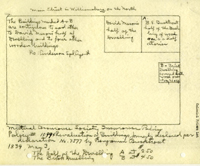 Colonial Prison Lot
Colonial Prison Lot
Mutual Assurance Society Insurance Policy
Policy # 10994 Revaluation of Buildings formerly declared per
Declaration No. 7577 by Benjamin Bucktrout
1839, May 3,
The Half of the Dwelling A at $250
The Brick Dwelling B at $450
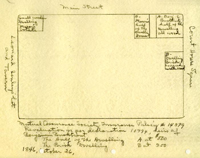 Colonial Lot 160
Colonial Lot 160
Mutual Assurance Society Insurance Policy # 14379
Revaluation as per declaration 10994, heirs of
Benjamin Bucktrout
The Half of the Dwelling A at $500
The Brick Dwelling B at $350
1846, October 26,
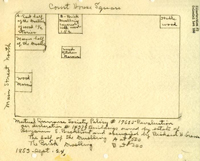 Colonial Lot 160
Colonial Lot 160
Mutual Assurance Society Policy # 17615 Revaluation
per declaration # 14379 Buildings owned by estate of
Benjamin E. Bucktrout and occupied by Richard H. [illegible]
The Half of the Dwelling A at $500
The Brick Dwelling B at $300
1853-Sept. 24,
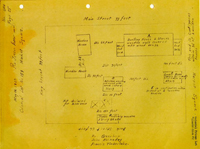 No. 644
No. 644
Page 25
May 12 1809 Ro Green how seal
Colonial Lot No 159 Market Square.
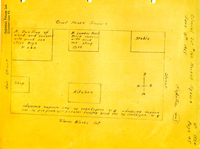 No 1524
No 1524
Page 45
Colonial Lot # 160 Market Square
June 15th 1815
Repiton seal
Illustration #3 - Historical Notes
Facts about the Greenhows and Louis Girardin
John Greenhow was merchant in Williamsburg ca. 1755-1787. He married a Miss Tyler. Greenhow died in 1787. (Gravestone in Bruton Parish Churchyard. The Virginia Gazette and Weekly Advertiser, Nicholson, ed., published September 1787, records a notice of his death.)
Greenhow's son, Robert Greenhow, was sole executor and apparent heir of his father. Robert Greenhow was a merchant also. In 1766, the Gazette carried notices that John Greenhow's store was located on the Main Street near the Church. The tax records and personal property lists for Williamsburg show that both Greenhows held lots in the city. On October 6, 1787, Robert Greenhow placed a notice in the Richmond paper concerning the settlement of his father's estate:
"Agreeable to the last will and testament of Mr. John Greenhow, late of this city, will be sold at public sale, on Thursday the 18th of October…all the real and personal estate of the deceased, (except the store Goods) in and about the city of Williamsburg, consisting of a large and commodious Dwelling House on the main street, 6 or 8 Houses and Lots on the back street, about 300 acres of land adjoining the Town…a number of valuable slaves…and a parcel of elegant household Furniture among which is a beautiful keyed Organ and a Spinnet…" (Virginia Gazette and Independent Chronicle, John Dixon, ed.)
Philip Barraud, in writing to St. George Tucker at Staunton on August 4, 1798, mentioned this fact: "Our neighbor Greenhow & his wife are both sick at Hampton."
Mary Winfield Scott, in the book Houses of Old Richmond, gives a short account of Robert Greenhow. She states that Greenhow "was born in the city of Williamsburg, in the year 1761. Owing to extreme youth, and the position of his father's family, he took no active part in the Revolutionary struggle, but joined with another in procuring the services of a substitute. He nevertheless served in a junior company, whose duty was confined to the immediate protection of Williamsburg, and the neighboring banks of the James River. He was several years Mayor of Williamsburg, and twice represented the county of James City in the Virginia Legislature. Greenhow took up his permanent residence in Richmond in the year 1810, and was mayor of the city during the last war, when, by his firmness and energy, he greatly contributed to the defensive preparation of the day."
Robert Greenhow married Mary Ann Wills. His daughter, Polly Greenhow, married Hugh Louis Girardin, great friend of Jefferson, and editor of The Argus.
Girardin came to Williamsburg as professor of modern languages at William and Mary College, it is thought, in about 1803. As son-in-law to Robert Greenhow, Girardin came into possession of a half-lot next to his father-in-law's house. Here he lived until 1810, when he moved to Richmond as editor of The Argus. While professor at William and Mary College, St. Memin made a miniature of Louis Girardin.
The facts about the Greenhows and Louis Girardin can be found in the following references:
- Tyler's Magazine,Vol. II, pp. 178, 280-281
- William and Mary Quarterly,1st Series, Vol. VI, pp. 182-184
- William and Mary Quarterly,1st Series, Vol. XIX, p. 146
- William and Mary Quarterly,1st Series, Vol. XXIV, p. 200
- William and Mary Quarterly,2nd Series, Vol. III, pp. 50-51, 239-240
- William and Mary Quarterly, 2nd Series, Vol. V, pp. 23; 122 Scott, Mary W., Houses of Old Richmond, pp. ---
Colonial Prison lot
Illustration #4
 FROM FRENCHMAN'S MAP 1782?
FROM FRENCHMAN'S MAP 1782?
 PHOTOSTAT COPY OF THE
PHOTOSTAT COPY OF THE
WILLIAMSBURG PLAT IN "WILLIAMSBURG,
THE OLD COLONIAL CAPITOL" BY LYON G. TYLER
Illustration #5
A copy of a picture by Williams, 1892, done in water color and entitled, "The old colonial Post Office," is on file in the Department of Research.
Illustration #6
[Mss. Collection - Library of College of William and Mary] Southall Papers, Folder 164. Legal Cases and Estates. James City County. Mason (David) estate. 1790-1845. 15 pieces including extract of will of Mary Langston.]Ibid.,[1840]
…Your orator further states that the said David Mason, at the time of his death was seised of, & entitled in fee to, a certain lot of land & tenement, lying in the City aforesaid, on the South side of Duke of Gloucester street, being the moiety of a lot or tenement formerly held jointly by the said David Mason & Benjamin E. Bucktrout, having thereon sundry buildings occupied by the said David at the time of his death. also another lot of land lying on the North side of said street, near the College, adjoining the lot belonging to the Estate of Leigh Ware decd. The said David was also possessed of a leaseheld tenement, leased of the Corporation of Williamsburg being originally a part of the public square in the said City, on which said lot or tenement there are sundry buildings, all of which have been held by the said Elizabeth, she taking the rents issues & profits thereof to her own use, ever since the death of the said David. That your orator is entitled to one equal fourth part of all the estate of the said David Mason decd, and the rents issues & profits...subject to the payment of debts and the widow's dower and distributive share being entitled thereto by reason of the conveyance of the said Robert Caldwell & Nancy his wife, and the said defendant Elizabeth is entitled to the residue of the said estate, by reason of the purchase from the said William, Henry, and John Mason herein before mentioned. That the said real estate and leasehold tenement are not well susceptible of division, and the value thereof would be much impaired by such division--that the interest of the parties would be much promoted by a sale thereof, and division of the proceeds of sale….
Inventory & appraisement to May 1839. [David Mason]
Appraisement of Negroes & personal Estate-Negroes…
| Total value | $5700.00 | |
| personal estate | 354.91 | $6054.91 |
| Mason's dwelling House | $ 750.00 | |
| Leased Tenement | $ 750.00 | 1500.00 |
| D. M. died early in 1839. | ||
| Rent & hires [of slaves] | ||
| … | $2020.00 |
[on next page]
| Appraisement brought over | $6054.91 | |
| Houses do do | 1500.00 | |
| Hires do do | $2020.00 | |
| Rents, Leased House 7 years $75 | 525.00 | |
| Rents, Dwelling--$75 | 525.00 | 3070.00 |
| Money left |
[N. B. This paper is not endorsed. A similar paper in which G. W. Southall figures out his ¼ of the value of David Mason's estate as $1279.45 is endorsed "David Mason's Est. Memo."]
Ibid.,
Folder 164.[November 1841]
David Mason died intestate without child or children, whereupon Nancy Caldwell, formerly Nancy Mason, sister of the said David, & now the wife of Robert Caldwell, became entitled as one of the heirs at law and distributees of the said David Mason, to one equal fourth part of his whole estate...subject to the dower...of his widow, Eliza D. Mason, said Nancy and Robert Caldwell of the county of Cumberland, Virginia have sold unto George W. Southall their undivided right in the estate of Mason.
[Williamsburg and James City Records, Deed Book I, pp. 542-543.]Deed 18 September 1857
between Mary E Neal of Fincastle Va. on the one part, & Susan Brown of Williamsburg Va - on the other part. Witnesseth: that in consideration of three hundred & fifty dollars the said Mary E Neal doth grant & convey unto the said Susan Brown the Certain brick building Situate near the Methodist Church in the City of Williamsburg & mentioned in the deed of Paul Repiton to Benj. E Bucktrout & descending to her (the sd Mary E Neal) by inheritance; & furthermore the Said Mary E. Neal doth Secure to the Said Susan Brown by general Warranty the right & title to the said property together with the privilege of a free passage way to her Cellar, through the lot now owned & occupied by the Relic of Davie Mason decd Witness the following Signature and Seal -
Mary E Neal (Seal)In Williamsburg Hustings Court Clerk's Office December 24th 1860
This Day the foregoing Deed of bargain and Sale, was received in the office with the Certificate of the Acknowledgment of Mary E Neal a party thereto, before two Justices of the County of Henrico, Virginia, thereon endorsed and thereupon together with the Said certificate admitted to record -Teste
Wm H. Yerby C. H. C.In the Clerks Office of James City County and the City of Williamsburg July the 23rd 1880
This Day the foregoing Deed was received in the Office aforesaid and together with the certificate thereon endorsed, was admitted to recordTeste:
Wm H E Morecock. C.
| Deeds | Grantor | Grantee | Bk | p. | Lot |
|---|---|---|---|---|---|
| Aug 14 | Mary J. Galt | Annie A. Galt | 4 | 471 | Debtors' Prison |
1905 rec. 23rd
Aug. 1905
This Deed, Made this 14th. day of August, in the year one thousand nine hundred and five, between Mary J. Galt (single) of the City of Williamsburg, State of Virginia, party of the first part, and Annie A. Galt, of the City and State aforesaid, party of the second part,
Witnesseth: That in consideration of the sum of five dollars, in hand paid, the receipt of which is hereby acknowledged, the said Mary J. Galt doth grant unto the said Annie A. Galt with General Warranty; all that lot of land with the building thereon, situate in the said City of Williamsburg, and bounded as follows, on the North by the alley-way separating the property hereby conveyed from the lot now owned by "The Banking Company of L. L. Direckson Jr.," on the East by the property of the City of Williamsburg, on the South by the land of Leonard Henley Jr; and on the West by the property of said Henley. This property is commonly known as "The Debtor's Prison."
Elizabeth R. Henley heired Leonard Henley property 1909
The said Mary J. Galt covenants that she has the right to convey the said land to the grantee; that she has done no act to encumber the said land; that the grantee shall have quiet possession of the said land, free from all encumbrances, and that she the said party of the first part, will execute such further assurance of the said land as may be requisite.
Witnesseth the following signature and seal.
Mary J. Galt, (Seal)
WILLIAMSBURG, March 13, 1766.
COMMITTED to the Corporation prison a Virginia born Negro fellow named JAMES, about 30 years old, 5 feet 10 inches high, has on a blue coat, cotton waistcoat and breeches, check shirt, and says he belongs to William Cureton of Prince George.
WILLIAM LANE
COLONIAL PRISON - 14
Bl. 13
This colonial prison is believed to have been erected for the use of James City County, soon after the county seat was moved to Williamsburg about 1715. (Journals of the House of Burgesses, 1712-1726, p. 151.) In 1705, an act had been passed by the Assembly directing the building and maintaining of "prisons, pillories, whipping-posts, stocks, and ducking-stools, in every county; and for settling the rules of prisons." (William Waller Hening, Statutes at Large, Vol. III, p. 267.) The Prison was used for the commitment of "debtors, criminals, and offenders" by the city of Williamsburg "on sufferance" since it had no jail. (Ibid., Vol. V, p. 263.) Several years after the removal of the seat of government to Richmond in 1780, the county was given permission to use the old gaol near the capitol. (Ibid>., Vol. XI, p. 381.) The city was granted the same privilege by an act passed in 1791, although the right of its use by the county and by the district in which Williamsburg was located was not impaired. (Ibid., Vol. XIII, p. 269.) It seems likely that this building was used as a dwelling, but limited time has not allowed sufficient research to authenticate this fact by documentary evidence. The prison is privately owned.
[There still seems to be a question as to whether this was the James City County prison, or perhaps the city prison. The following quotation seems to give weight to the case for the county's having had a prison on the same lot with the old courthouse, as Tyler affirmed:
And be it further enacted,… That the said justices of James City, be, and they are hereby impowered to sell, at public auction, for the best price that can be got for the same, the land whereon their present court-house and prison stand (being part of a lot in the said city) together with the court-house and that they, the said justices, or any four of them shall and may convey the same to the purchaser or purchasers… (Hening, Statutes, Vol. VIII, p. 420.)]
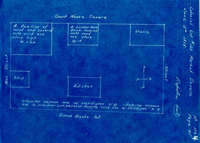 No 1524
No 1524
Page 45
Colonial Lot #160 Market Square.
June 15th 1815
Repiton seal
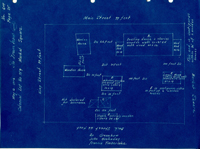 No 644
No 644
Page 25
May 12 1[illegible]6 Ro Greenhow seal
Colonial Lot No 159 Market Square.
